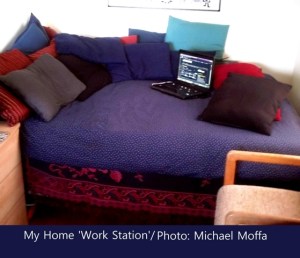The Future of Teleworking: You Can Bed on It

Cisco Corporation has reported that, by 2016, 43% of working Americans will be working from home, as “teleworkers”, at least on a part-time basis.
Teleworkresearchnetwork.com (TRN) estimates that although less than 2% of U.S. employees work from home the majority of the time (not including the self-employed), 40% have jobs that are compatible with teleworking.
TRN also estimates that if those employees telecommuted just half of the time (which TRN says is approximately the U.S. average for those who do telework), the U.S. economy would save $650 billion per year. (TNR’s lengthy breakdown of the specifics of these savings is an eye-opening “must read”.)
So, if you are currently or prospectively among the other 57%, you may want to think about two things: why you should consider joining the ranks of teleworkers and how to do it. (And if you are an employer, think about why and how you should broaden teleworking in your business.)
A quick online search—the obvious way to find such jobs—turned up plenty of jobs for teleworking (a.k.a. “telecommuting”) recruiters as well as for everybody else. One such posting, at TekSource Canada, specified among the 17 detailed requirements for the job of technical recruiter that the candidate, “must be able to work at home”. (Italics mine, although “must” is ambiguous—as between “must also work at home” and “must insteadwork at home”. However, since the job requires attending job fairs, conferences, etc., venturing out of the house is certain to be required occasionally. Be sure to clear this up when applying for or advertising a job.)
A Wheatberry Mayberry Telework-and-lifestyle
Here in the Sunshine Coast’s laidback (yet very touristy) Gibsons, B.C., off-season population about 5,000, (where I have recently taken up permanent residence on a pristine beach, in an ocean-side cottage), the only kind of commute I have to make is up a steep energy-burning forest-flanked mountain hill to replenish that energy with a stop for a freshly-baked Wheatberries’ muffin; to the waterfront and the only nearby Chinese restaurant, for my daily lunch combo; or to Fong’s, the harbor-side Mayberryish mom ‘n pop grocery store, for everything else the universe contains, which, like some weird Twilight Zone oriental emporium, they seem to stock.

Commute to an office? I’d sooner commute to a dentist’s.
(Un)Usual Incentives to Telework
If you haven’t started teleworking or offering it to employees yet, common sense and common knowledge will suffice to acquaint you with most of the familiar reasons for and ways of doing it, which then leaves the less obvious ones. These are the more familiar incentives:
- expanded employee pool, as otherwise home-bound, immobilized workers, such as remote rural, wheelchair, dialysis-dependent workers or others, who, for whatever reasons, become more employable
- reduced health costs, as workplace contagion risks diminish
- easier company compliance with disabilities legislation
- time and gasoline savings (if you still need a car)
- reduced automobile wear-and-tear, tolls, maintenance and parking costs (if you still need a car)
- contributions to environmental protection and conservation (by driving less)
- reduced risk of commuting accidents (by driving or riding public transportation less)
- minimized commuter stress and hassles
- flexible work scheduling
- personal efficiency and comfort (by working in your personally designed space rather than the company’s)
- multi-tasking capabilities
- increased family or pet time
- improved work-life task integration, prioritization and balance
This much is pretty easy to understand, even if some of it isn’t already familiar. However, there are rather less obvious reasons to telework—reasons that include health and societal incentives:
- (Life-saving) Choice of “postural allocations”:As will be discussed in my upcoming in-depth report and interviews with medical experts on the health risks associated with sedentary work and life styles, sitting all day—irrespective of how much strenuous exercise you do or don’t have otherwise—can be lethal.
That’s the upshot of research of “inactivity physiology” specialists Dr. James Levine of the Minnesota Mayo Clinic and Professor Marc Hamilton, a researcher with the Pennington Biomedical Research Center in Baton Rouge, Louisiana. Their recent, widely reported research (which contrasts with already well-studied exercise physiology studies) indicates that one’s “postural allocation”, e.g., sitting, standing, moving, lying down horizontally or being semi-reclined, has significant consequences for cardiovascular health and life expectancy, and that—contrary to popular and mistaken belief— some deleterious effects of prolonged inactivity cannot be offset by vigorous exercise if total sedentary time is not decreased.
Other studies confirm the dangers of prolonged sitting: A recent massive Australian study led by Hidde van der Ploeg, a senior research fellow at the University of Sydney, analyzed self-reported data from more than 222,000 people aged 45 and older, and found that mortality risks soar 40% after 11 hours of total daily sitting. For those sitting between 8 and 11 hours compared to those sitting fewer than 4 hours per day the risks are 15% higher.
No wonder I hate sitting. Although I am only a lay(down)man, I know what I find physically and psychologically comfortable, and sitting upright for prolonged periods is, for me, neither—especially if I were to have no choice, e.g., in virtue of working in an office that has only desks.

If I am vertical, I’m in motion, save for sink and shower time.
Having to not only remain seated or standing for most of the day, but also to have no choice makes for a truly stressful combination—bearing in mind the contrary opinion of some friends and others who will say they prefer sitting to lying down because being horizontal or semi-reclining just makes them sleepy.
Other long-standing research, by Dr. R. Karasek, suggests that being denied “latitude” on the job, i.e., the authority to control how you do your job, if not the job load, is one of two key factors in work-related cardiovascular disease, the other being job loads that are too onerous. My layman’s guess is that being pretty much forcedto sit or stand (or even to lie down, or have a foot/paw immobilized, e.g., in lab studies) constitutes a loss of job and task latitude and a source of stress (with possible negative health implications)—whether forced by the physical environment or by the demands of others (the latter introducing an element of social stress distinct from the physical and other psychological stress).
Anyway, unpleasantness is unpleasant, and being denied choice when it’s desired and desirable is precisely that—unpleasant.
As for my contrarian friends, I can’t resist speculating that the main reason being fully relaxed with lots of pillows propping up one’s back, shoulders and neck would make one sleepy is that sitting at a desk the rest of the day is so exhausting that sleepiness is inevitable once the chance to doze off presents itself. Their reluctance to abandon exhausting vertical work postures may very well perpetuate itself.
In any case, teleworking allows reviewing the postural allocation options for comfort and health, and choosing the one or combination that works best for our work, relaxation and health—with due consideration of the cardiovascular and other health risks and benefits of whatever style chosen.
(Note: my preference for a more horizontal work style is not to be construed as “medical advice”. Consult your own physician and published research should you have any questions about what posture is best for you, bearing in mind that, however comfortable working in bed may be, it is still a sedentary and possibly risky style.)
- Competitive compensation-package advantage: If you are able to apply for a job as a telecommuting teleworker (including a job as a recruiter), you may be able to accept a lower salary than other applicants, in virtue of not having to live close enough to the job, if it is in an urban center, to make physical commuting tolerable or practical. Likewise, teleworking increases the odds of finding affordable housing, e.g., suburban, which allows accepting a lower salary offer and therefore gaining a competitive advantage as a job applicant or candidate. Then there are the reduced transportation and other commuting costs, e.g., fewer outside meals, which makes a lower salary or expense-account offer more palatable and a job candidacy more attractive.
- Optimization of daily and circadian rhythms:Much teleworking allows greater, if not complete pause-button control over work, sleep, meals, exercise and other daily activities—especially jobs whose tasks are stacked with generous time frames, e.g., research and writing with less than immediate deadlines, rather than continuous real-time cascades, e.g., of the kind associated with live tech support or professional consultation. This means having a healthier work-life balance and generally healthier, well-harmonized life, with greater control of the pace and timing of work and off-hours play. In particular, teleworking allows maintaining normal “circadian” rhythms, i.e., biorhythms regulated by planetary rotation, by not having to fly so far as to induce and experience stressful, disruptive and exhausting jet lag.
- Shift from activity-focused to ends-focused job management:Teleworking allows both employee and management to focus on ends rather than means. Instead of having to do a job in conformity to the company-monitored methods and activities specified to do it, the employee works in conformity to the goals and objectives of the task. What counts are results, not workplace behavioral protocols.
- Renaissance of “Gemeinschaft” (community) culture: It is true that working at home, as I do, can be very isolating for some people—especially for those whose remote workplace interactions have dominated their lives so completely they don’t know their local neighbors. But if you stop commuting to a bustling urban corporate office and instead interact only with local “village” people, including neighbors, your face-to-face interactions are likely to conform to the time-tested, historically dominant and traditional form of friendly, patient and leisurely “Gemeinschaft” (community-focused, rather than commercially-focused “Gesellschaft”) relationships and interaction.
Are all these reasons enough to guarantee that not only is teleworking the wave of the future, and a tide to ride, but that it is also a very smart idea for you to give personal consideration?
You can bed on it.
Or maybe, like me, even swim out to greet and ride the wave.

